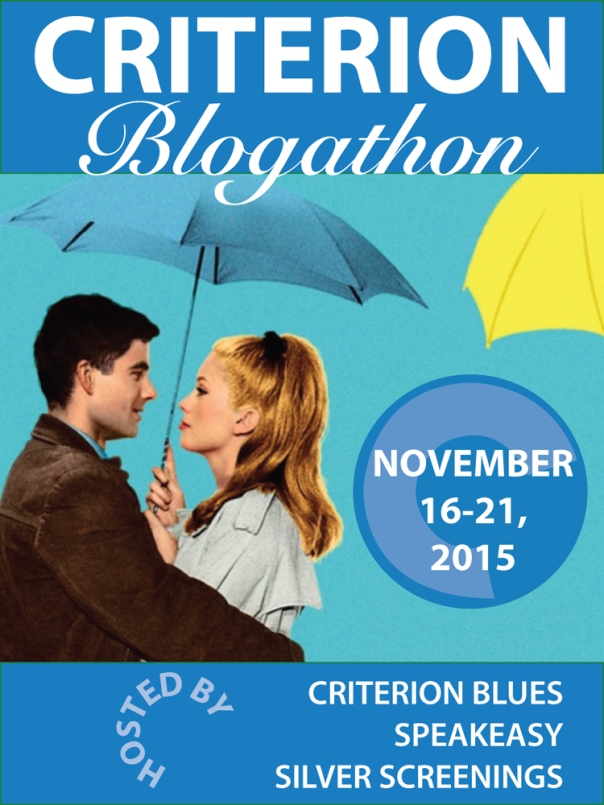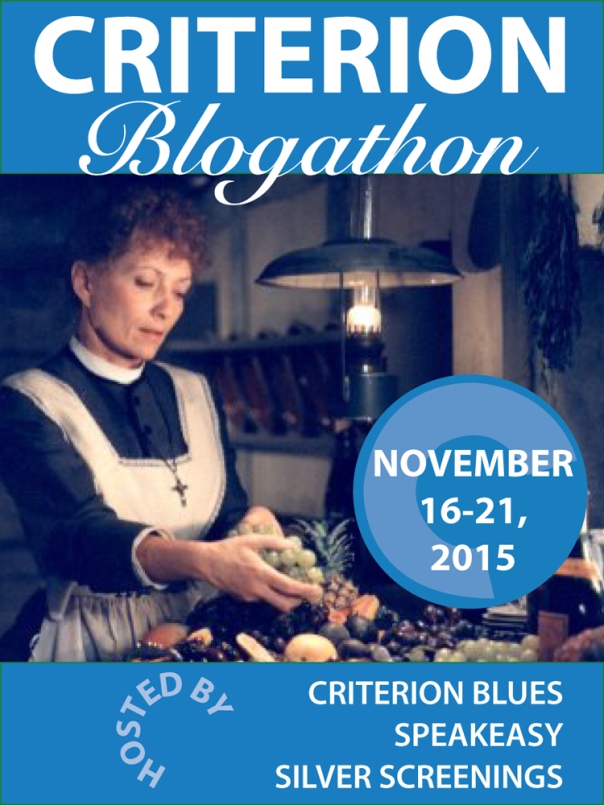Category Archives: Blogathon
CCU16: February 2016 New Releases & The #CriterionBlogathon

Aaron, Mark, Kristina Dijan (Speakeasy) and Ruth Kerr (Silver Screenings) discuss the February 2016 Criterion Collection line-up and then we delve into the Criterion Blogathon, which was an epic experience for all of us. We talk about some of the behind the scenes info, give out prizes, talk about the social media thrills with the #CriterionBlogathon, and give our thanks to all who participated.
Or listen here to it here:
Or direct download/listen to the MP3.
Show notes:
Outline:
0:00 – Intro, Housekeeping
9:20 – News & February Releases
38:40 – Criterion Blogathon
Intro
Kristina – Speakeasy Blog | Twitter
Ruth – Silver Screenings Blog | Twitter
Image of 4 Month, Three Weeks, 2 Days
News
Kristina’s In Cold Blood review
Aaron’s The Apu Trilogy Review
Kitchen Conservations: Gaspar Noé
February 2016 Releases
Criterion Blogathon
Recap, Day One: English Language Films released before 1947
Recap, Day Two: Europe and Mexico
Recap, Day Three: English Language Films, 1947-1980.
Recap, Day Four: Asian Cinema
Recap, Day Five: English Language films, 1981 to present.
Recap, Day Six: Essays and Box Sets.
F For Films – Favorites from the Criterion Blogathon
Grand Prizes:
Research: Cinematic Scribblings
Portrait: Coffee Gone Cold
Originality: Criterion Affection
Humorous: CineMaven’s Essays from the Couch
Where to Find Us:
Mark Hurne: Twitter | Blog | Letterboxd
Aaron West: Twitter | Blog | Letterboxd
Criterion Close-Up: Facebook | Twitter | Email
Criterion Blogathon: Day 5 Recap
Welcome to the penultimate recap post for this highly successful #CriterionBlogathon. Again, thank you to all the participants — bloggers and readers. The response has been tremendous.
Today’s recap is the third installment of the English language series, from 1981 to present.
Tune in tomorrow for the final day, which will be the biggest. We’ll be covering the big Essays and Boxsets. You can see the full schedule over at Speakeasy.
On Sunday we will be recording a special episode of Criterion Close-Up. Kristina and Ruth will join us as we talk about the week. We’ll be announcing the Grand Prize winners and talking about some of our favorites, so make sure you tune in.
I also want to thank Joshua from F for Films for listing his favorite posts. We love seeing that sort of engagement!
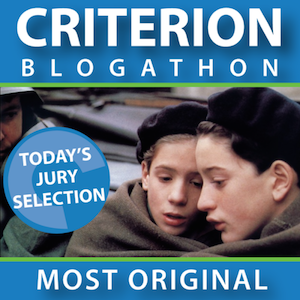
Pop Culture Pundit – The Musical Pulse of Andrew Haigh’s “Weekend.”

Marvel Presents Salo – Beastie Boys Video Anthology
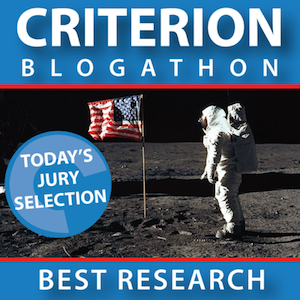
A Scunner Darkly – The Unbearable Lightness of Being

Checkpoint Telsar – Robocop
USA
Superfluous Film Commentary – Paris, Texas (1984)
Checkpoint Telstar RoboCop (1987)
A Scunner Darkly – The Unbearable Lightness of Being (1988)
MovieRob – Do the Right Thing (1989)
Tales from the Border – Mystery Train (1989)
Reel Distracted – Dazed and Confused (1993)
Loud Green Bird – Being John Malkovich (1999)
Marvel Presents Salo – Beastie Boys Video Anthology (2000)
Movie Musings and Podcastings – Mulholland Drive (2001)
Nerdy but Flirty – The Royal Tenenbaums (2001)
MovieRob – The Curious Case of Benjamin Button (2008)
UNITED KINGDOM
Wonders in the Dark – A Room with a View (1985)
Defiant Success – Insignificance (1985)
Journeys in Darkness and Light – Fish Tank (2009)
Pop Culture Pundit – Weekend (2011)
CANADA
Our Planet Burke – Scanners (1981)
Marvel Presents Salo – Videodrome (1983)
THIS JUST IN –
A Shroud of Thoughts – That Hamilton Woman
Silver Scenes – Robinson Crusoe on Mars
Criterion Blogathon: Day 2 Recap

Welcome to the second day of the #CriterionBlogathon! You can read yesterday’s recap over at Kristina’s Speakeasy blog.
Before I get to the entries, I have to address the elephant in the room. The terrorist activities that took place this past Friday in Paris are abhorrent, tragic and maddening. We are saddened, horrified and angry all at once. They have cast a shadow over this Blogathon, as a couple bloggers had to back out because they were personally affected. Others, like Adam over at Hope Lies at 24 Frames Per Second, could not find the words. Please read his post as he addresses the events more directly. He asks the same question that Truffaut asked decades ago, “Is the cinema more important than life?” My answer is no. Absolutely not. However, the cinema has some healing powers. Many of today’s entries are about films that take place in France. This day is dedicated to the people of Paris. We are with you, and we celebrate you. #ParisIsLife!
On a lighter note, some have asked whether Criterion is aware of the Blogathon. The answer, as they published on today’s Criterion Current, is yes.
As they mention, the reason we chose this week was to celebrate two fantastic releases — The Apu Trilogy and In Cold Blood. I published my review of The Apu Trilogy today and highly recommend it. Kristina will be reviewing In Cold Blood, and Ruth will be reviewing Ikiru.
Now, on to Europe … and Mexico too.
FRANCE
The first award goes to ..

Criterion Affection – Children of Paradise (1945) – Michele may have a small word count, but it’s the image that matters. She illustrated a gorgeous picture about her subject!
The Cinematic Frontier – Beauty and the Beast (1946)

CineMaven’s Essays From the Couch – Quai des Orfevres (1947) – Theresa makes us laugh with her comical take on a French classic and her taste in pastries.
Ferdy on Films – Jour de Fete (1949)
Silverbluesnow – The Earrings of Madame de… (1953)
The Stop Button – Diabolique (1955)
Pioneer Pride – Elevator to the Gallows (1957)
Confessions of a Broccoli Addict – Hiroshima Mon Amour (1959)
Film Grimoire – The Testament of Orpheus (1960)
Movie Mania Madness – A Woman is a Woman (1961)
4 Star Films – Au Hasard Balthazar (1966)
Midnight Only – Belle du jour (1967)
4 Star Films – The Young Girls of Rochefort (1967)
filmvulture – Army of Shadows (1969)
Robert Regan Guest at CineMaven’s Essays From the Couch – Love on the Run (1979)
DENMARK
portraitsbyjenni – Babette’s Feast (1987)
GERMANY
Serendipitous Anachronisms – The Threepenny Opera (1931)
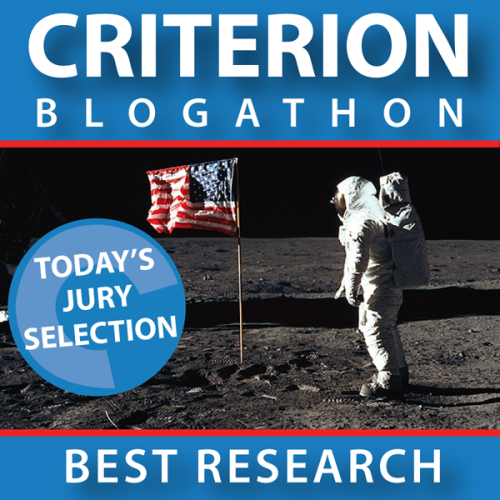
SkeletonPete – Vampyr (1932) – Pete wins for mixing up academic research with mining the DVD extras.
The Lonely Critic – The Bitter Tears of Petra Von Kant (1972)
Moon in Gemini – Ali: Fear Eats the Soul (1974)
ITALY
unfocusedframes – Umberto D (1952)
The Jump Cut at Lime Fiesta – Salo, or 120 Days of Sodom (1975) (NSFW!)
SPAIN
Krell Laboratories – Viridiana (1961)

Psychoplasmics – Cronos (1993) – Winner for the great portrait of Guillermo Del Toro.
SWEDEN
Sweet Freedom – The Virgin Spring (1960)
MEXICO
Classic Movie Night – Y tu mamá también (2001)
… and leftover from yesterday:
The Apu Trilogy, Satyajit Ray


This post is part of the Criterion Blogathon hosted by Silver Screenings, Speakeasy and Criterion Blues (yours truly).
The story of the Apu Trilogy, at least in 2015, cannot be told without discussing the exhaustive restoration that The Criterion Collection undertook in order to let a worthy print see the light of day. Below is a short video that summarizes the restoration, but I recommend you watch the longer and more comprehensive piece on the Apur Sansar disc. It shows the tragic condition of the burnt prints, and we hear from the people who were instrumental throughout this painstaking process. This was my second viewing of Pather Panchali and Aparajito, and the print was night and day compared to what I initially saw. Not enough can be said about the tremendous work that Criterion has put into not just the box set, but the visual presentation.
These posts will include spoilers of major events in the trilogy.
PATHER PANCHALI, 1955

Both Apu’s cinematic story and Satyajit’s career began with Pather Panchali. Many consider it to be the crowning achievement of the series, and it currently sits at number 41 on the BFI Sight & Sound Poll (Apur Sansar is 245 and Aparajito is not on the list.) Ray, influenced by Italian Neo-Realism and Poetic Realism, wanted to portray a different type of India than had been seen before. The fact that we are still talking about the trilogy sixty years later proves that he succeeded beyond his wildest dreams. The debut may not be as fine-tuned as the two that would follow, but it portrays an innocence and simplicity hardly seen before or since.

The first major character that we identify with is young Durga, Apu’s older sister, although we first meet her before meeting Apu. She is mischievous, like her younger brother will eventually become, but she is also benevolent. She is a thief, whether she takes beads or fruit, but she has a big heart. She shares food with her aging Auntie. When her younger brother enters the world, she takes him under her wing and shows him that there is a magnificent world lurking beyond their impoverished village.
The Ray family is situated in their rural, ancestral home. It is in a small village, but aside from a select few, we barely get to meet any of their fellow neighbors. It is almost as if the family is in their own little corner of the forest, away from the trappings of society. They are also living in poverty, barely able to subsist during some seemingly insurmountable economic challenges. This may be why Durga steals — not out of an innate need to misbehave — but as a means of survival. We see her watch others eat, and we see the hunger pains on her face. This is a girl that has often gone to bed hungry.

Apu is what you would expect a young boy to be. Despite the same challenges that Durga and the rest of the family face, he has a lust for adventure. He is mischievous and full of energy, playing often and disrupting the peace and quiet of his parents. Early on, after catching him in some misadventure, his mother tells him, “You were not born to survive.” This quick line of dialog would prove fateful and perhaps motivational. Apu was unequivocally born to survive, as we would learn throughout the trilogy.
The Ray parents love their children, but they are faced with difficult decisions as to how to provide for them. Harihar, the father, is not making ends meet in the village and must look elsewhere for work. That ends up being a lengthy journey where he loses touch with his family. Rather than being an absent father, his motivation is out of love. He is trying to find a way to provide for his family, and hoping that the village will provide for them while he is away. Things are trying and much of the film consists of the trio — mother, son and daughter — trying to persevere, hoping for a sign of better things to come.

There are emotional highs and lows. As mentioned before, Durga loves to show Apu the wonders of the world. One of the most memorable moments is where he witnesses a train passing, which would be a reoccurring and among the most recognizable motifs of the series. Having not seen a train before, he is overwhelmed with joy as this marvel of technology, this behemoth, passes by in an instant. He runs through a field trying to get a better glimpse, and he seems to be gliding along with the black locomotive.
The lows are tragic. Durga and Apu find themselves in a torrential rainstorm. What begins as Durga playing in the refreshing rain, ends up being miserable discomfort. As a dutiful older sister, she shelters her brother from the rain without thought of herself, and the consequence is tragedy. We experience tragic events throughout the series, yet Ray is not manipulative. There are few anguished death scenes. In fact, many of the deaths happen off-screen. The tragedy is in the reactions, and that is why these films are so affecting. We understand the emptiness of loss, even if we are not as unfortunate as the Ray family. We also understand and respect resilience and fortitude, which are qualities in many of the characters, most notably Apu.
While Pather Panchali is Ray’s inaugural film and perhaps not as technically proficient, he makes use of film language to accompany the dramatic events as they unfold. He uses interesting camera angles, and blocks his actors in locations so that we see more than just traditional close-ups and shot-reverse-shot. The filmmaking allows us to see them in their element, as part of their surroundings, and the plot unfolds realistically and naturally.
APARAJITO, 1956

The world of Apu shifts gears after the death of his sister. Prospects look brighter as his father has found sound employment in a large city along the Ganges river. If the railroad were a new world, this is like a new planet. As a young boy, Apu roams along the banks of the Ganges, finding spiritual rituals, physical demonstrations of vitality and strength, and even wildlife in monkeys — which he had been compared to by his mother.

This middle chapter is fragmented, almost as if it is two films, each with a tragedy to overcome. Apu’s personality and future are shaped more by what happens during Aparajito than Pather Panchali, and it functions as an effective connection between the adolescent and the grown man.


The middle chapter is centrally about Apu, but the most important element is the changing dynamic between mother and son. After they are left alone in the world and forced away from Benares, their relationship evolves. They begin this new life (again) dependent on each other, but as become entrenched, they drift apart.
I haven’t discussed the acting so far, but I’ll say that, in my opinion, the finest performance of the series is Karuna Bannerjee as Apu’s mother. There are many other great performances in the trilogy, such as Chunibala Devi’s take as Auntie in Pather Panchali, or Soumitra Chatterjee as Apu in Apur Sansar, among others, but Bannerjee is the one that has stuck with me the most.

Often her performance does not require dialogue, as brief glimpses at her facial expressions reveal (or betray?) her emptiness. She remains a mother and tries to nurture her child, urging him either on a career as a priest, or begrudgingly as a student. She supports him to the detriment of herself, even though she selfishly despairs. She wants to force him to remain close, against his will, but that is like taming a caged tiger. Apu is a survivor and his youthful ambition is unstoppable. Her reluctant sacrifice and Apu’s apathy makes her the most endearing.
Apu is played by two different actors, as the film encompasses two chapters of his life. Again, the film can be seen as an extension of the beginning and ending. The early Apu is more like his Pather Panchali self, a little older, but still adventurous and mischievous. The Apu that occupies the latter half of the film resembles the character we meet in Apu Sansar. We see an intelligent, literate young adult, who devotes himself to learning and understanding the world. His prized possession is a globe that his school has given him.
The reality is that children grow up and leave their parents behind. I don’t believe that Apu loses the love he holds for his mother, but her loneliness is an impediment to his ambition. He struggles at school, and the constant reminder of her emptiness, usually in the form of letters, is a distraction. When he does visit, he is tentative and not all there. Later he laments that when he is home, he does not get enough studying done. What is left unsaid is that is because he has to fulfill the emotional needs of his lonely mother. It is tragic in an existential way, as is much in the series. Both characters are imperfect, and we understand the motivations for both of them without much judgement. Even though it is tough to see, the film portrays it in a realistic manner that, again, it earns the stirring moments.
Even though in hindsight, Aparajito is seen as a transitional piece, it stands on its own. In fact, when it was finished, Satyajit Ray did not intend to make another sequel. Fortunately for us, he had a change of heart, and wrapped the series up with another masterwork that does provide some resolution.
APUR SANSAR, 1959

Trains no longer impress Apu. They are now an annoyance. This was established in Aparajito, but is hammered home in the final film. They are a nuisance, a necessarily means of transportation, and even a harbinger of dire things to come. Apu is no longer thrilled with the train. Apu is no longer thrilled with life. His mother was alone in the last film, but now, years later with an impressive education, it is Apu that is alone in his world. However, unlike his mother’s loneliness where she felt abandoned, his is self-imposed. He comes to resent this cruel world.

We first encounter Apu as a young intellectual that retained some of the ruthless abandon of his adolescent self. He lives in a small apartment and finds that he is overqualified for suitable employment. Instead he is a hopeless romantic. He plans to eventually write a novel, but for this period of his life, he is content living in the moment and enjoying his freedom.
Apu’s indolent existence is contrasted by his old school buddy, Pulu. Even though they are old school buddies, the seeds of class difference are planted in Aparajito and more pronounced in Apur Sansar. However friendly and loyal to his old friend, Pulu is from an upper class family. He does not have to write a great novel someday. He is more pragmatic, as he will inherit a capitalistic advantage. In this respect, he and his friend diverge in their outlook in life. If not for chance, they may have lost touch and gone separate ways, but they become linked in a familial way by accident.

Despite their differences, Pulu sees that Apu is sharp and deserves a chance at life. He is ultimately a good person. Due to a mix-up at a wedding for Pulu’s cousin that Apu attends, the bride is left without a groom. They believe that if she is not married, she will be cursed, and the old friend coaxes Apu to be a stand-in groom. At first he resists, and something comes over him, and he relents. This may be motivated by his romanticism and thirst for experiencing all that life has to offer, or he may simply have been lonely. He becomes married to a person that he has never met before. In an instant, his loneliness is over.


The class differences emerge again when Aparna, coming from a wealthy family, must live with a man with hardly any quality of life to offer. It is a rough transition, but he is a fine match personally, and a genuine and insatiable love overcomes them. The joy that older Apu feels with Aparna is reminiscent of the joy that the younger Apu experienced with the train. This is a new world for him, and despite their lack of means, they make the best of their situation. In this respect, they embody the poverty-stricken innocence from Pather Panchali. She enters this world and feels comfortable.

One of the most memorable scenes is where they are riding together in a carriage, professing their love toward each other. The scene is written, acted and shot beautifully, even if it is in shot-reverse-shot style with a hint of darkness. Their love seems childlike and adorable. Unfortunately, at least to this point, glee and joy are not emotions that will remain. Tragedy strikes yet again, and this time is it too difficult for Apu to overcome. He descends into a life of self-pitying, wandering, bitterness.
From a filmic and stylistic standpoint, Apur Sansar ties a bow around the previous two films. There are many motifs, whether visual, mise-en-scene, or character-based that draw from its predecessors. Even though the final film is more overt with some of the symbolism (although not with all), it actually enhances the prior two films. I discovered many elements that helped me appreciate my second viewings of the earlier films. Some of them are notable, such as the mirror shots, the close-ups through a hole cut in cloth, and of course, the duality of the magnificent and dreaded trains. There are others. We can find simple mannerisms of the character in all three films, that become accentuated in Apur Sansar. The stoic disconnection that the character experiences is also a stark contrast to the Apu we had known. Since this is all filmed with convincing neo-realism, the character evolution is convincing and that much more affecting.
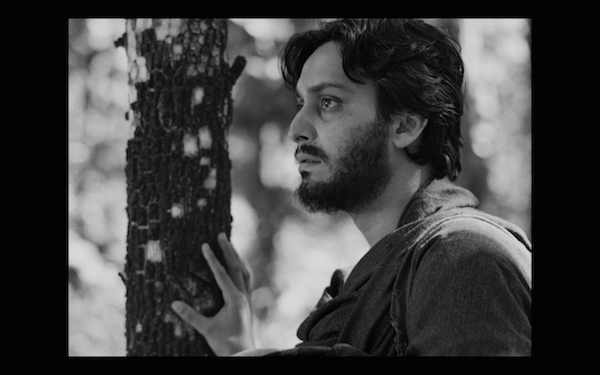
How would the tragedies that Apu experiences transform other people? If I were to wager a guess, many would resemble the older Apu in some respect. I cannot imagine how my world-view would be dismantled if I experienced the same type of despair. The fact that Apu’s plight is about as low as imaginable makes the final payoff all the more powerful. It hurts to see someone in despair, locked away from the world and shut off from its charms — especially someone who was so quick to smile during earlier, dire circumstances.

The ending of the trilogy is, in my opinion, one of the most powerful moments in film history. Ray waits until the absolute last minute to give us a glimpse of hope. We barely have time to absorb it until we are to wonder where Apu’s adventures will take him next, but we are given a sense of optimism. Again, this is not a manipulative and sentimental happy ending. We may not be convinced that things are going to be just dandy. Apu will undoubtedly face further challenges in his life. The final moments are so powerful because he has been to the abyss and partially come back. Even if he has not fully entered back into society, he has regained something to cling to that will give his life meaning. Hopefully his fortune will turn and he will not lose something dear to him again, but if so, we are reasonably assured that he has the tools to live a fruitful life. For this reason, the ending, however optimistic, is pure beauty.
The Criterion Collection edition of The Apu Trilogy comes with gorgeous restorations of the three films, a number of supplements, and a nice booklet. I recommend that rather than watching the supplements for each film one at a time, to watch the films first and then go back and watch them disc-by-disc. The supplements speak to a degree about the particular film, but are best experienced having experienced the entire trilogy.
The interviews were informative. They gave a glimpse of the experience of working with a film legend in his early years. We even hear from the man himself, and find that he had an indelible charm and kind authority. In one supplement he reads from an essay, but in such a commanding and hypnotizing voice that it is apparent that film is not the only vehicle in which he told stories.
From the interview with Soumendu Roy and all the actors, we learn of the project’s meager beginnings. It was essentially an independent film, and Pather Panchali had many of them learning on the job (although Mitra and Ray had previously apprenticed with Ray on The River.) Given the obstacles, both financial and logistical, it is a marvel that the project was not only made, but was such high quality that it has endured.
My two favorite supplements are on the Apur Sansar disc. The visual essay with Mamoun Hassan is a comprehensive journey through the production and themes of the trilogy. Finally, the aforementioned restoration documentary by Kogonada is the crowning achievement. Even though it clocks in at under 15 minutes, it unveils what is the true gem of this set — the quality of the films. Without the efforts of all of these individuals, for all of these years, such art would not be seen as it should be. This is certainly the release of the year. However long Criterion operates as a company (hopefully for a long time), this is a release that they will look back at with pride as cinephiles, young and old, discover and rediscover this mesmerizing piece of art.
Thank you, Criterion.
The #CriterionBlogathon is Imminent

It is hard to believe how much time has passed since we announced The Criterion Blogathon. I know that quite a few are typing with fury as they finalize their submissions, and there have been a few early entries (thank you!).
This is going to be a huge event. How huge? Just take a look at the full schedule posted at Speakeasy. She will kick it off on Friday with a summary of the day’s posts, and I’ll follow on Tuesday, and then Ruth, and so on. Please note that we will be reblogging each other’s posts, so subscribers will get an email every day of the week.
There will also be a lot of activity on social media. If you tweet, Facebook, or whatever, please use the hashtag #CriterionBlogathon. Maybe we can even get it trending.
Whether you are participating or just reading, please do us a favor and click on the links, read the articles and comment. Please be supportive of those who are putting so much energy and enthusiasm into this event. We know it is a lot. Scratch that, it is a boatload. Hopefully you can do what you can.
Below are some of the early links. They will be incorporated into the summary posts, but with so much tremendous content coming, it doesn’t hurt to start early.
Cinematic Scribblings – The Adventures of Antoine Doinel – The 400 Blows, Antoine and Colette, Stolen Kisses.
Movie Movie Blog Blog – All That Jazz (1979)
The Last Drive-In – Carnival of Souls (1962)
Pioneer Pride – Elevator to the Gallows (1957)
Journeys in Darkness and Light – Fish Tank (2009)
Destroy All Fanboys! – High and Low (1963)
Pioneer Pride – I Will Buy You (1956)
The Cinematic Frontier – The Life and Death of Colonel Blimp (1943)
Our Planet Burke – Scanners (1981)
Criterion Blogathon – Things to Come
Hello, fellow film buffs. We have been quiet for a little while, but with the #CriterionBlogathon just under a month away, we are about to roar!
Most importantly, we are imposing a deadline for topic choice submissions as of this Friday, October 23, 2015. We have updated the Blogathon roster here, and are currently at 170 topics. If you want to participate, this is the last call for you to secure a topic. After checking the roster, please complete this form to participate.
You may also be interested in the podcast that we recently recorded with Kristina over this past weekend. We discussed not only the blogosphere, blogathons, and online film community, but also this specific blogathon. Hopefully you will find it to be an interesting discussion. We certainly enjoyed it! Kristina blogged about her experience here.
The Blogathon will take place over six-days, from Monday, November 16th until Saturday, November 21st. We have divided the topics into sixths, which was not an easy task when you have films from all over the globe that span roughly a hundred years. We divided them by region of the world and time period. Kristina, Ruth, and I will each be hosting two days worth of posts.
The complete schedule is going to be unveiled next week! It will be revealed one day at a time. I hope you follow all three blogs, but if for whatever reason you do not, we will re-blog each post. You can treat these days as “deadlines.” It is not a strict deadline and we will still edit your contribution into the ‘thon if it is late, but there are some incentives for being on time or even early.
Incentives? Does this mean recognition? Does this mean things?
We are giving away awards for each day! The criteria will be:
Most Humorous
Most Original
Best Research
Best Portrait
Once the event is completed, we will give out a Best in Show prize for each category, which will be a yet-to-be-announced actual thing. That is, an actual thing that someone would want! Yes, something that would actually cost money! Out of the large number of entries, this will be a tough choice and we hope everyone will be a good sport about it. We also hope everyone will give it their all.
To recap: Deadline, Podcast, Schedule, Awards, Grand Prizes!
Keep your eyes peeled towards any of the three hosting blogs next week.
Episode 11: January 2016 Releases and the Classic Film Blogosphere
Aaron, Mark and Kristina Dijan talk about the just announced January 2016 Criterion Collection releases. We also delve into the film blogosphere. There is a huge blogging community that spans across multiple platforms, social or technological, and Kristina is at the heart of that community.
Or listen here to it here:
For other apps or mobile devices, try this link.
Or direct download/listen to the MP3.
Show notes:
Special Guest: Kristina Dijan from Speakeasy. You can find her on Twitter.
Outline:
0:00 – Intro, Welcome, Housekeeping
17:25 – News
27:30 – January 2016 Releases
52:15 – The Film Blogosphere
Intro
Criterion Blogathon – Deadline for submissions this Friday, 10/23.
Alambrista – first Criterion Short Cuts episode.
InSession Film: 99 Homes, The Third Man
New header image at Criterion Blues. Thanks, Aaron Bird.
Jean Grémillon During the Occupation – giveaway. Listen for details.
News
Criterion Current: Guy Maddin and Evan Johnson – The Graduate mention.
Cohen Media Acquires Merchant-Ivory.
Nerdist – More on new Wes Anderson project.
January 2016 Releases
The Complete Lady Snowblood
Bitter Rice
The American Friend
Inside Llewyn Davis
Gilda
The Film Blogosphere
Movie Musings and Podcastings – Mark’s new blog.
Reader Programs: WordPress, Feedly, Reeder
Classic Movie Hub’s Blogathon page.
Blogathon Info:
My The Blob contribution to the Great Villain ‘thon.
Classic Movie History Blogathon
Last year’s O Canada Blogathon.
Veteran Bloggers:
Classic Film & TV Cafe
Shroud of Thoughts
Greenbriar Picture Shows
Laura’s Misc Musings
Self-styled Siren
The Stop Button
Blogs Mentioned:
Mike’s Take on Movies
Blonde at the Film
Movies Silently
Now Voyaging
House of Self Indulgence
Wonders in the Dark
Interested in Sophisticated Fun
Criterion Reflections
Rupert Pupkin Speaks
Pre-Code.com
Outspoken and Freckled
Aurora’s Gin Joint
Cinematically Insane
Blogger Groups:
Classic Movie Blog Association – eBook here and here.
Classic Movie Hub
Where to Find Us:
Mark Hurne: Twitter | Letterboxd
Aaron West: Twitter | Blog | Letterboxd
Criterion Close-Up: Facebook | Twitter | Email
Criterion Blogathon: Blogs & Topics
The initial surge has slowed down, but we still have an impressive 121 topics claimed for our Blogathon, and that number is surely to grow. We’ve been asked often whether people got their first choices, and here is the official unveiling. Most people did get their first choice, and I think that’s because many checked out the First Round page. Thank you for that!
This same info is being pasted at the official Blogathon HQ and this page will not be updated with new submissions, but the other one will.
One thing we noticed is a lot of USA films. We get it, but we think that will probably change now that the biggest American films are claimed. The UK, France and Japan also have a good number of entries.
Kudos to the brave souls that claimed box sets or essays. A lot of these topics look like grad papers, which is terrific. Just because these are going to require the most work, we are going to have them posted on the last day.
We will divide the rest of the days mostly by country and era, and we’ll post a full schedule along with publish dates down the road.
Did we mention prizes? We will be offering some for each day. We are still working on an objective and fair way to judge the winners, but with such a large volume of entries, please be understanding and respectful. By that same token, we hope you will do your best and post quality content.
BOX SETS
Criterion Blues – The Apu Trilogy
The Wonderful World of Cinema – Three Wicked Melodramas
// Lillybelle Production – The Lower Depths (both)
Wrong Reel – 3 Silent Classics by Josef von Sternberg
John Likes Movies – Warped World of Kureyoshi Kurahara
The Howard Bannister Report – Sabu in the Criterion Collection
ESSAYS
Jahnke’s Electric Theatre – Criterion and Animation
L’Amour Fou and Movies, Too! – Jacques Demy
Make Mine Criterion! – (My) Top Ten List
Wolffian Classic Movies Digest – Thief of Bagdad Arabian Fantasies
The Joy and Agony of Movies – Nicolas Roeg
The Criterion Completion – Collecting Criterion
Threedonia – Christian Faith in Classic European Cinema
365 Days 365 Classics – The Indian ethos in Satyajit Ray’s Apu Trilogy
365 Days 365 Classics – Women in Satyajit Ray’s Cinema
Cinema Cities – Classic Film Noir in the Criterion Collection
Scream Blu Fans! – Criterion and Horror
TITLES BY COUNTRY
CANADA
To be Confirmed – Videodrome (1983)
Cinema Versus – The Brood (1979)
Midnight Only – Belle du jour (1967)
CZECH
Life In Cinema – Marketa Lazarova (1967)
DENMARK
In The Good Old Days Of Classic Hollywood – Master of the House (1925)
FRANCE
The Stop Button – Diabolique (1955)
Pioneer Pride – Elevator to the Gallows (1957)
Criterion Blues – Rules of the Game (1939)
The Film Tank – Rififi (1955)
CineMaven’s: Essays From the Couch – Quai des Orfevres (1947)
Spitball Army – Les Miserables (1934)
Film Grimoire – The Testament of Orpheus (1960)
The Lady Eve’s Reel Life – La Ronde (1950)
ericapeplin.com – News From Home (1976)
Movie Mania Madness – A Woman is a Woman (1961)
Hope Lies at 24 Frames Per Second – The Soft Skin (1964)
Spellbound by Movies – Judex (1963)
Ferdy on Films – Jour de Fete (1949)
Cameras and Joysticks – Pierrot le Fou (1964)
Cameras and Joysticks – Breathless (1960)
The Cinematic Frontier – Beauty and the Beast (1946)
GERMANY
The Movie Rat – The Tin Drum (1979)
Aperture Reviews – M (1931)
Moon in Gemini – Ali: Fear Eats the Soul (1974)
Smitten Kitten Vintage – Pandora’s Box (1929)
Serendipitous Anachronisms – The Threepenny Opera (1931)
SkeletonPete – Vampyr (1932)
INDIA
Totally Filmi – Charulata
IRAN
Pinnland Empire – Close-up and Taste of Cherry (double feature)
Cinema and other Impossible Pursuits – Close-Up (1990)
Wrong Reel – Taste of Cherry (1997)
ITALY
TheVoid99 – La Dolce Vita (1960)
The Jump Cut at Lime Fiesta – Salo, or 120 Days of Sodom (1975)
unfocusedframes – Umberto D (1952)
JAPAN
Silver Screenings – Ikiru (1952)
Mookes and Gripes – Mr. Thank You (1936)
Destroy All Fanboys! – High and Low (1936)
Seven Doors of Cinema – Jigoku
The Blazing Reel – Tokyo Story (1953)
Caftan Woman – Sanjuro (1962)
Laura’s Miscellaneous Musings – Early Summer (1951)
Critica Retro – Late Spring (1949)
The Terrible Claw Reviews – Godzilla (1954)
RUSSIA
Cinephilia – The Cranes are Flying (1957)
SPAIN
Krell Laboratories – Viridiana (1961)
TAIWAN
Coffee Gone Cold – Yi Yi (2000)
UNITED KINGDOM
Sister Celluloid – Green for Danger (1946)
Blogue cinéastique – The Innocents (1961)
A Shroud of Thoughts – That Hamilton Woman (1941)
Wonders in the Dark – A Room with a View (1985)
Defiant Success – Insignificance (1985)
The Blue Chair – This Sporting Life/If…
Journeys in Darkness and Light – Fish Tank (2009)
GirlsDoFilm – An Angel at my Table (1990)
Mildred’s Fatburgers – Watership Down (1979)
Pop Culture Pundit – Weekend (2011)
The Cinematic Frontier – The Life and Death of Colonel Blimp (1943)
Phantom Empires – The Deceivers (1988)
USA
Speakeasy – In Cold Blood (1967)
Now Voyaging – Ride the Pink Horse (1946)
The Other Critic – 12 Angry Men (1957)
Second Sight Cinema – Lonesome (1928)
Mookes and Gripes – Brief Encounter (1945)
Movie Movie Blog Blog – All That Jazz (1979)
Twenty Four Frames – A Hard Day’s Night (1964)
Aurora’s Gin Joint – My Darling Clementine (1946)
Love Letters to Old Hollywood – Heaven Can Wait (1943)
Movies Silently – Pool Sharks (1915)
Arturo – The Last Temptation of Christ (1988)
B Noir Detour – Pickup on South Street (1953)
Superfluous Film Commentary – Paris, Texas (1984)
Mike’s Take on the Movies – Jubal (1956)
Cinema Gadfly – Make Way for Tomorrow (1937)
Classic Movie Man – The Lady Eve (1941)
Back to Golden Days – Arsenic and Old Lace (1944)
Loud Green Bird – Being John Malkovich (1999)
Wide Screen World – Spartacus (1960)
Cindy Bruchman – Fantastic Mr. Fox (2009)
Old Hollywood Films – Red River (1948)
Cinema Monolith – Ministry of Fear (1944)
In The Good Old Days Of Classic Hollywood – To Be Or Not To Be (1942)
An Ode to Dust – Safety Last! (1923)
Film Ruminations – The Third Man (1949)
In The Good Old Days Of Classic Hollywood – Written on the Wind (1956)
Mildred’s Fatburgers – Shock Corridor (1953)
Hometowns to Hollywood – The Freshman (1925)
Floyd R. Turbo – Paths of Glory (1957)
Interested in Sophisticated Fun? – Two Lane Blacktop (1971)
Dismal Whimsy – The Uninvited (1944)
A Scunner Darkly – The Unbearable Lightness of Being (1988)
F for Films – Notorious (1946)
Criterion Close-Up – Mulholland Drive (2001)
Grand Old Movies – Island of Lost Souls (1932)
The Last Drive-In – Carnival of Souls (1962)
Diary of a Country Pickpocket – The Furies (1950)
Diary of a Country Pickpocket – Stagecoach (1939)
Cinematic Catharsis – Kiss Me Deadly (1955)
Nerdy but Flirty – The Royal Tenenbaums (2001)
Micro-Brewed Reviews – Fiend Without a Face (1958)
In The Good Old Days Of Classic Hollywood – My Man Godfrey (1937)
The Hitless Wonder Movie Blog – The Most Dangerous Game (1932)
Moviefreak.com – The Black Stallion (1979)
Checkpoint Telstar RoboCop (1987)
Cameras and Joysticks – The Game (1997)
First Round of Blogathon Responses
Edit: Unless you have been notified, you were given your first choice. Full lists with blog links will be posted soon.
Wow! We expected a good turnout, but never did we expect such an overwhelming amount of submissions in the first 24 hours. Scratch that, we still have 5.5 hours to go before we get there.
The below titles have been “claimed.” Some were second choices; most were first. There were two that had both topics claimed and they aren’t listed here. We will reach out to those people individually. If you really want to cover your topic and it is already taken, you can do it in a creative way. For example, one person is doing a Kiarostami double feature and one of the films is Close-Up, but another person claimed the film by itself.
Even though participation is amazing, we want it to continue to grow. We want people to see this as an event, not just a Blogathon. Please spread the word. Grab our banners from the announcement post. Post on your blog that you are participating and invite your friends.
Help us make this a blast of an experience!
Please also note the HQ page to see the latest updates. Eventually all titles and blog links will be posted there.
We also LOVE that there are some creative titles where people are looking not only at films, but larger Criterion pieces. One example is Criterion and Animation. Another is Nicolas Roeg, and there are many more like that and probably more coming. Keep these up and you’ll make us really happy.
TOPICS THAT ARE TAKEN
(My) Top Ten List
3 Silent Classics by Josef von Sternberg
12 Angry Men
A Hard Day’s Night
A Room With A View
A Woman is a Woman
Ali: Fear Eats the Soul
All That Jazz
An Angel at My Table
Arsenic and Old Lace
A Taste of Cherry
A Woman is a Woman
Being John Malkovich
Belle de Jour
Breathless
Brief Encounter
Carnival of Souls
Charulata
Christian Faith in Classic European Cinema
Close-Up
Close-Up & Taste Of Cherry – double feature
Collecting Criterion
Criterion and Animation
Diabolique
Early Summer
Elevator To The Gallows
Fiend Without a Face
Fish Tank
Fritz Lang’s M
Godzilla
Green For Danger
Heaven Can Wait
High and Low
Ikiru
In Cold Blood
Insignificance
Island of Lost Souls
Jacques Demy
Jigoku
Jour de Fete
Jubal
Judex
Kiss Me Deadly
La Dolce Vita
La Ronde
Late Spring
Les Miserables
Lonesome
Make Way for Tomorrow
Marketa Lazarova
Master of the House
Ministry of Fear
Mr. Thank You
Mulholland Drive
My Darling Clementine
My Man Godfrey
News from Home
Nicolas Roeg
Notorious
Pandora’s Box
Paris Texas
Paths of Glory
Pickup on South Street
Pierrot le fou
Pool Sharks (1915) from the WC Fields DVD
Quai des Orfevres
Red River
Ride The Pink Horse
Rififi
RoboCop
Rules of the Game
Sabu in the Criterion Collection
Safety Last!
Salo, or 120 Days of Sodom
Sanjuro
Shock Corridor
Spartacus
Stagecoach
Taste of Cherry
That Hamilton Woman
The Apu Trilogy
The Beastie Boys Video Anthology
The Black Stallion
The Brood
The Cranes are Flying
The Freshman
The Furies
The Game
The Indian Ethos in Satyajit Ray’s Apu Trilogy
The Innocents
The Lady Eve
The Last Temptation of Christ
The Life and Death of Colonel Blimp
The Lower Depths (Renoir & Kurosawa)
The Most Dangerous Game
The Royal Tenenbaums
The Soft Skin
The Sporting Life/If ….
The Testament of Orpheus
The Third Man
The Tin Drum
The Unbearable Lightness of Being
The Uninvited
Thief of Bagdad Arabian Fantasies
Three Penny Opera
Three Wicked Melodramas
To Be Or Not To Be
Tokyo Story
Two Lane Blacktop
Umberto D
Watership Down
Weekend (2011)
Women in Satyajit Ray’s Cinema
Vampyr
Viridiana
Yi Yi
Announcing the Criterion Blogathon

We are pleased to announce the first annual Criterion Blogathon!
The blogathon will take place November November 16th to 21st, and I have the pleasure of co-hosting with two of my favorite bloggers and favorite people: Kristina from Speakeasy and Ruth from Silver Screenings. This is not their first rodeo, as they’ve hosted numerous fantastic Blogathons. Earlier this year they hosted the Great Villain Blogathon and the Beach Party Bash Blogathon. What’s great about these two is that they turn these Blogathons into events, which is what we are planning for November.
Just last year, The Criterion Collection celebrated their 30th anniversary. That’s an amazing accomplishment for a physical media label. They began with laserdiscs, transitioned to DVDs, and now are the top boutique label for Blu-Ray/DVD. They have established credibility with their film choices, ranging from mainstream classics to some of the best art films the world has ever seen. Today they continue to add to their library, adding modern auteurs and classic films. I’m of the opinion that they have something in their catalog that appeals to anyone with a passion for film and history.
This Blogathon is scheduled to take place over six days in November to correlate with the release of The Apu Trilogy and In Cold Blood. During the month of November, they are also releasing Code Unknown, Julien Duvivier in the Thirties, Ikiru and Don’t Look Back. We think that The Apu Trilogy is an important release for the history of film and we couldn’t pick a better time to celebrate the label.
How does this work?
If you are a blogger, you can choose any film or topic from the Criterion catalog. If you’re unfamiliar with Criterion releases, check out the links below for films offered in a variety of media:
Laserdisc
DVD
Blu-ray
The Eclipse Series
Hulu (Available to US users only.)
iTunes
You can also search Criterion for titles or people. Or just Google an actor/actress and Criterion.
We expect good participation, so we are not allowing duplicate entries with one exception. Any title that is going to be released in November is fair game. October releases do not count. (Sorry to everyone who wants to cover Mulholland Drive!) This is on a first-come, first-served basis.
You are welcome to write about a film, a director, an era, a DVD release, or anything that is related to The Criterion Collection. These do not have to be formal DVD reviews. You can write from whatever style or angle that you think appropriately covers the topic within the theme of your blog.
You can sign up by completing the form at the bottom of the page or clicking here. Please think of two good choices. You may not get your first choice and maybe not your second, but we hope that everyone can find a personally interesting topic to write about. With more than a thousand titles in the catalog, there are plenty to go around.
Please also keep the hashtag #criterionblogathon in the back of your mind. We’ll be using that on Twitter prior to and during the event. Maybe if enough of you sign up, we can even get it trending!
The Blogathon will take place for six days. Kristina, Ruth and Aaron will alternate posting recaps each day. We will separate the daily recaps by era and region, but we’ll get into that later.
One more thing: We ask that you try to upload your Blogathon posts in time for us to post it in that evening’s recap. If you post late, you will still be included, but probably won’t get as many readers.
We can’t wait for this mega blogging event!. Grab a banner and share it with your blog’s readers.
Any questions? Feel free to comment below.
Participants:
Aaron, CriterionBlues.com, The Apu Trilogy
Kristina, Speakeasy, In Cold Blood
Ruth, Silver Screenings, Ikiru



